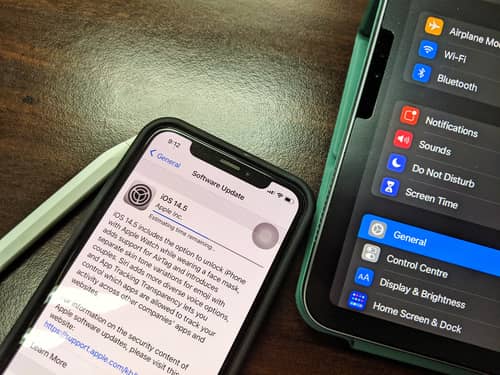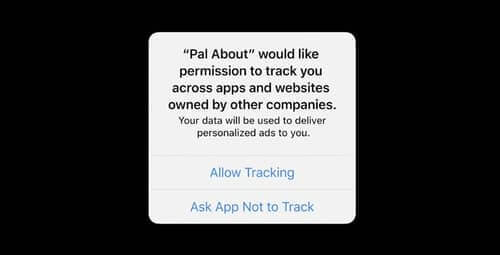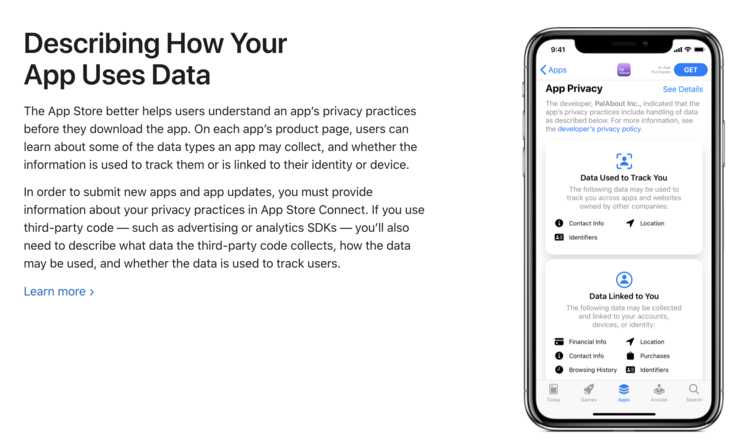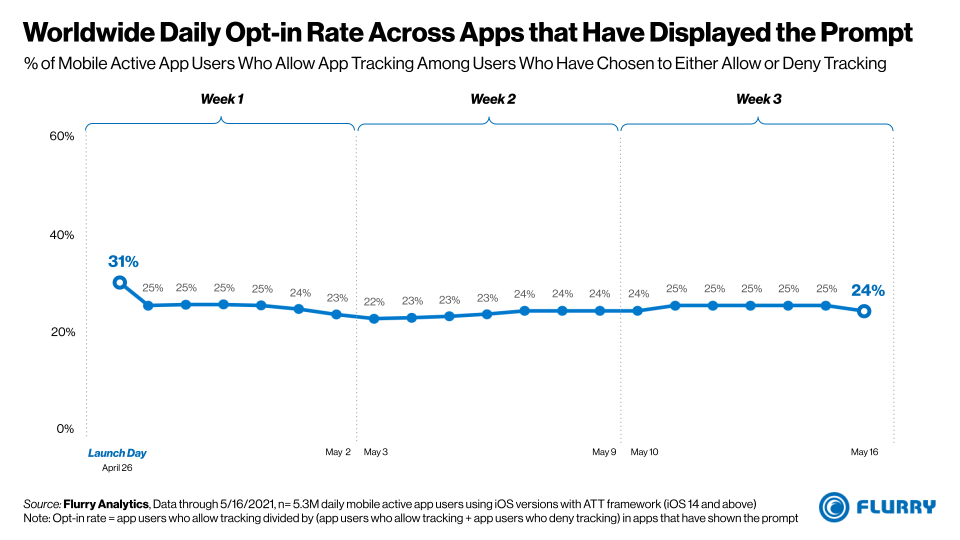On 26th April 2021, Apple released the latest version of its operating system, iOS 14.5. It came with a bunch of new updates including a big new privacy framework called App Tracking Transparency (ATT). From now on, all devices running on iOS 14.5 will require mobile app publishers to ask for user permission for tracking and accessing device identifiers, such as the Apple IDFA.
But what is Apple’s IDFA? And what do the changes mean for the future of targeted advertising? While the true impact of the iOS 14.5 changes remains to be seen, this guide will tell you everything you need to know right now.
*This blog was written by PlotProjects, the leading provider of geofencing and location-based experiences for companies with mobile apps.
In this article we’ll cover:
- The basics about IDFA Apple and ATT
- Implications and preliminary opt-in rates since iOS 14.5 changes
- IDFA privacy
- The future of targeted advertising and how brands are dealing with it

What is Apple’s IDFA?
What is IDFA and why Apple killed it
The Identifier for Advertisers (IDFA), also known as ‘IDFA Apple’ or ‘IDFA IOS’ is a unique, random, and resettable device identifier assigned to a user’s iOS device. The IDFA was specifically designed to give advertisers and app owners the ability to anonymously identify a mobile device and collect information about the usage of the phone whilst advertising.
How IDFA Apple works
Simply explained, imagine a merchant has shop X and a mobile user with the store’s shopping app uses the app to look for a new pair of shoes. Merchant X can use the user’s IDFA to collect that data. If that same person later uses their mobile browser to search for something, Merchant X can target them with an advertisement featuring the shoes they were looking at in the shopping app.
Google Ads can go one step further. The Apple IDFA can be used on a desktop browser so the user with that IDFA can be targeted when back at home sitting behind the desktop and searching for something completely different. Google Ads will know that the IDFA has been using the Merchant X app and therefore Merchant X can place ads directly targeted at that IDFA.
So, the Apple IDFA allows advertisers and app owners to track data so they can deliver customized advertising, set up accurate targeting, and link app installation to the ad campaign that has captured a particular user– all without revealing the personal identity of that user.
Does Apple still use IDFA?
Apple’s new App Tracking Transparency (ATT) framework introduces a change to how an IDFA works. This is because in iOS 14.5 there is a requirement for apps to ask users if they want to be tracked. Now when a user installs or updates the new iOS, a prompt will appear alerting the user to opt-in or opt-out of sharing this information.

So, what is Apple doing with IDFA?
If a user does not allow IDFA IOS tracking, Apple suggests using its new SKAdNetwork feature. The privacy-focussed feature enables advertisers to still be able to get statistical insights without relying on the IDFA. For example, to see how many mobile users saw or clicked on an ad and then opened a webpage or installed an app. So there is at least an alternative, although the attribution data is less granular than what Apple IDFA provided so personal ads are not possible.
How will iOS 14.5 changes affect the market?
Apple has decided to ask for an explicit opt-in to allow IDFA IOS tracking. Generally, less people tend to opt-in, therefore as a result of these changes, some users are expected not to.

Because the information collected by the Apple IDFA was used by advertisers to serve personalized ads, the advertisement income from apps who depend on ads will decrease. Facebook for example depends heavily on providing advertisers with the ability to direct ads based on the IDFA.
It is expected that apps who depend on advertising income and who have many iOS users will have to look for other ways to generate income to cover the “free” services they provide. One model is to start asking users for a subscription fee, however Apple takes a 30% cut from the subscription fees, so the loss will still be felt.
Many brands are now looking for ways to still be able to target end-users with “relevant ads” rather than generic ads, without violating Apple’s IDFA privacy policy. Some are focusing on motivation and bonuses for the users who opt-in, while others are working on alternative ways to identify devices.

Location data and IDFA privacy
With IDFA, apps can collect and share location data for location-based marketing. For example, it enables an app to serve relevant ads, notifications or coupons to a user at a certain geographical location. Apps such as Facebook, Instagram, and Google all collect data used to advertise based on location. This type of location based advertising is a lot more efficient.
Location data and IDFAs are also shared with databuyers. A databuyer is a company that collects IDFAs and adds all sorts of information to it. Location is one thing, but this data can also include user searches, for instance if someone is looking for flight tickets or searching for clothes, advertisers can then buy the data profiles and use that information for their advertisements online, both for mobile and desktop.
Apps that collect data (often in exchange for free use of an app) earn money from selling it to these data brokers. Here there will be another loss felt. With less IDFAs and less location data, income will decline for those apps. Again, this is likely to drive subscription income but also an opportunity – give app users a choice – opt-in for the Apple IDFA or otherwise pay the subscription fee.
Another side effect we expect is that advertisers will look to collect first party data from users directly.
What are the ATT opt-in rates so far?
The total number of opt-in rates remains to be seen but early figures show that the rates are higher than anticipated at around 25-30% and many industry experts are predicting that figures could rise over the coming months.
The highest increases were seen in the US, UK, Australia, New Zealand and Japan. On a category level, hyper casual games, education and photography apps have advanced the most.

Does this impact the PlotProjects SDK?
Since Apple’s ATT framework only deals with IDFA collection, it will not impact the location services provided by the PlotProjects SDK. Additionally, PlotProjects has always been a privacy-focused company and the Plot Plugin does not require IDFA collection by default.
Location permissions were a hot topic a while ago which means consumers are already familiar with the standard location opt-in prompt. And since targeting with IDFA is becoming more difficult, targeting real time via location is becoming more valuable in conducting accurate targeted marketing.
Am I required to comply simply because I am a customer of PlotProjects?
- This will not impact the majority of customers because iOS 14.5 changes only deals with IDFA, not location permissions. Linking the ATT framework to the PlotProjects SDK is only needed if you use the Plot Plugin as a means for collecting/monitoring IDFAs.
- The new prompt is only about IDFA permissions. Location permissions are handled through a different prompt which is not impacted.
- Setting the IDFA value is up to the app publisher, PlotProjects only monitors the opt-ins. If you are a customer and would like to read more about this, please check out our documentation here: Advertising identifier – How to get started.
iOS 14.5 changes – looking ahead
With the newly rolled-out ATT, we at PlotProjects are keeping a close eye on the situation in the industry, and we support the development of alternative solutions and opportunities that will secure both user privacy and attribution post iOS 14.5 changes.
As fewer users opt-in to Apple IDFA tracking, advertisers will be looking for new ways to attribute the results of their marketing efforts. The changes set forth by iOS 14.5 changes do not impact location services, and we predict that location data will become ever more valuable as an alternative way to link users with their activity.
While we all may experience some impacts of Apple IDFA privacy, you will not meet any significant challenges in your use of the PlotProjects SDK. If you have any concerns, please contact us today.
